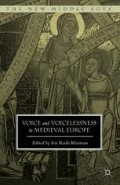Abstract
Mysticism is the domain in which language, confronted with the Absolute, tests its own limits. Following this idea, we might say that the Virgin Mary, as she is presented to us in Christian tradition, offers mysticism a paradigmatic figure.1 As mother to Jesus Christ, Mary finds herself, through the Incarnation, in one of human life’s most significant relationships—that of mother and child—with God himself. Yet the canonical Gospels remain largely taciturn regarding the physical and affective contact between Mary and her child, or the whole range of manifestations that relationship supposes. In the evangelical canon, Mary expresses herself verbally by means of fiat, uttering just a few words at Cana, and making only rare interventions during Jesus’s public ministry.2
Access this chapter
Tax calculation will be finalised at checkout
Purchases are for personal use only
Preview
Unable to display preview. Download preview PDF.
Notes
On Mary during the Middle Ages, see Clelia Maria Piastra, ed., Gli studi di mariologia medievale: Bilancio storiografico, Atti del I Convegno Mariologico […] Parma 7–8 novembre 1997 (Florence: SISMEL—Edizioni del Galluzzo, 2001);
Miri Rubin, Mother of God: A History of the Virgin Mary (New Haven, CT: Yale University Press, 2009), 303–12;
Marielle Lamy, “Marie toujours plus sainte,” in Structures et dynamiques religieuses dans les sociétés de l’Occident latin (1179–1449), ed. Marie Madeleine de Cevins and Jean-Michel Matz (Rennes: Presses Universitaires de Rennes, 2010), 321–37.
On the Virgin Mary in the Bible, see Pierre Grelot, “Marie (Vierge), I. Ecriture sainte,” in Dictionnaire de spiritualité (Paris: Beauchesne, 1980), 10:409–23;
and Mary Margaret Pazdan, “Mary, Mother of Jesus,” in The Anchor Bible Dictionary, ed. David Noel Freedman (New York: Doubleday, 1992), 4:584–86.
The most frequently cited of these apocryphal texts include the Liber de ortu beatae Mariae, ed. Jan Gijsel (Turnhout: Brepols, 1997);
and Liber de nativitate sanctae Mariae, ed. Rita Beyers (Turnhout: Brepols, 1997).
Jean-François Cottier, Anima mea: Prières privées et textes de dévotion du Moyen Age latin (Turnhout: Brepols, 2001);
see also David S. Hogg, Anselm of Canterbury: The Beauty of Theology (Burlington, VT: Ashgate, 2004);
and Eileen C. Sweeney, Anselm of Canterbury and the Desire for the Word (Washington, DC: Catholic University of America Press, 2012).
Christian Belin, La conversation intérieure: La méditation en France au XVIIe siècle (Paris: Honoré Champion, 2002).
Patrick Arabeyre, “Un prélat languedocien au milieu du XVe siècle: Bernard de Rosier, archevêque de Toulouse (1400–1475),” Journal des savants 3–4 (1990): 295–306.
Nicole Bériou, “Les sermons latins après 1200,” The Sermon, ed. Beverly M. Kienzle (Turnhout: Brepols, 2000), 389–90.
On this context, see Philippe Wolff and Marcel Durliat, “L’épreuve des temps (mi-XIVe—mi-XVe siècles),” in Histoire de Toulouse, ed. Philippe Wolff (Toulouse: Privat, 1988), 183–222.
On this context, see Marielle Lamy, L’Immaculée Conception: Etapes et enjeux d’une controverse au Moyen Age (XIIe–XVe siècles) (Paris: Institut d’études augustiniennes, 2000);
Citation from Irène Rosier-Catach, “Discussions médiévales sur l’expression des affects,” in Le Sujet des émotions au Moyen Age, ed. Piroska Nagy and Damien Boquet (Paris: Beauchesne, 2008), 208.
Alain Boureau, “La mise en scène du divin,” in L’Evénement sans fin: Récit et christianisme au Moyen Age (Paris: Les Belles Lettres, 1993), 39–54.
On the text as musical instrument, see Ineke van’t Spijker, Fictions of the Inner Life: Religious Literature and Formation of the Self in the Eleventh and Twelfth Centuries (Turnhout: Brepols, 2004), 235–39.
On the question of affective evolution in the meditative genre, see Jean Baruzi, Saint Jean de la Croix et le problème de l’expérience mystique (Paris: Salvator, 1999), 430–31;
and François Trémolières, “Haine de la méditation? Notes sur les enjeux d’une querelle théologique,” Rivista di storia e letteratura religiosa 41.3 (2005): 539–40.
Sabrina Stroppa, “L’Ars meditandi nel Seicento mistico.” Rivista di storia e letteratura religiosa 41.3 (2005): 515–36.
Burcht Pranger, The Artificiality of Christianity: Essays on the Poetics of Monasticism (Stanford, CA: Stanford University Press, 2003), 13.
On this subject, see André Wilmart, Auteurs spirituels et textes dévots du Moyen Age latin: Etudes d’histoire littéraire (Paris: Etudes augustiniennes, 1971).
Editor information
Copyright information
© 2015 Irit Ruth Kleiman
About this chapter
Cite this chapter
Giraud, C. (2015). Mary between Voice and Voicelessness: The Latin Meditationes of Bernard de Rosier. In: Kleiman, I.R. (eds) Voice and Voicelessness in Medieval Europe. The New Middle Ages. Palgrave Macmillan, New York. https://doi.org/10.1007/978-1-137-39706-5_12
Download citation
DOI: https://doi.org/10.1007/978-1-137-39706-5_12
Publisher Name: Palgrave Macmillan, New York
Print ISBN: 978-1-137-39705-8
Online ISBN: 978-1-137-39706-5
eBook Packages: Palgrave Literature CollectionLiterature, Cultural and Media Studies (R0)

